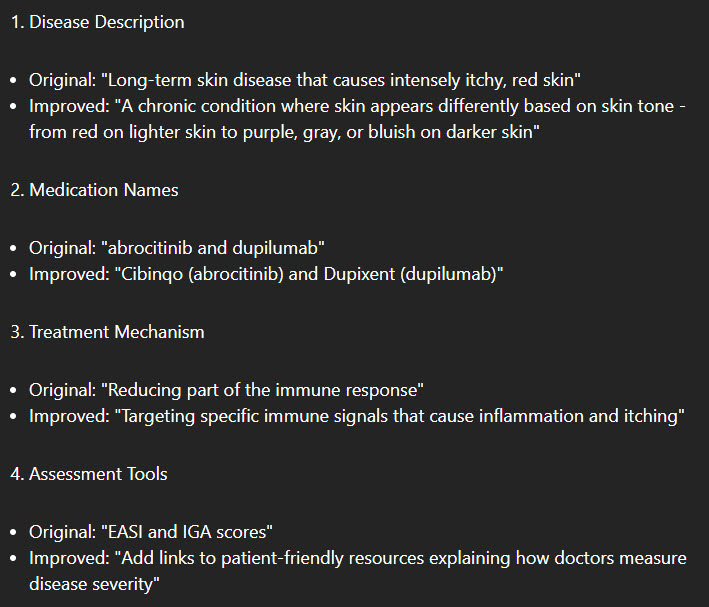

As someone who has lived with atopic dermatitis (AD), also commonly known as eczema, for over 30 years, I’ve navigated a wide range of treatments and therapies, both as a patient and as a professional consultant in healthcare. For the past seven years, I’ve worked with pharmaceutical companies, healthcare organizations, and patient advocacy groups to ensure that patient perspectives are front and center in medical research and communication. From this dual vantage point, I’ve seen firsthand the disconnect between complex scientific studies and the patients those studies aim to help. This is why I am a passionate advocate for lay summaries and, more importantly, for including patients in the creation, review, and dissemination of those summaries.
Medical research is evolving faster than ever before and cutting-edge treatments and diagnostics are emerging. For patients, understanding the research behind potential treatments can provide hope, reassurance, and empowerment. However, this understanding is often blocked by a wall of jargon-filled research papers, clinical trial reports, and medical terminology that is inaccessible to most patients.
That’s where lay summaries come in. A well-written lay summary translates dense, technical research into clear, concise, and accessible language that patients can understand. But it’s not just about simplifying; it’s about making the information meaningful to patients. Lay summaries can help patients make informed decisions about their care, track the progress of treatments, and advocate for themselves in conversations with healthcare providers.
As a patient advocate and content creator, lay summaries also enable me to share accurate, research-based information with my online community. In the era of rampant misinformation, this accessibility is more essential than ever. When research is accessible and written in terms I can grasp, I can then translate that information in a way that resonates with my community, offering them clarity and helping counter the flood of false information that circulates online. Without access to accurate, understandable summaries, I—and other advocates—are left unable to relay critical findings back to the communities we serve.
In my own journey with AD, I’ve experienced how empowering it is to understand the science behind my condition. When I can grasp how a treatment works or why a particular therapy was developed, it changes the way I approach my health. I’m not just a passive recipient of care; I’m an active participant. That’s the power of patient-friendly information, and it’s why lay summaries are critical.

While lay summaries are essential, they are only truly effective when patients are involved in their creation. Too often, these summaries are written by researchers, doctors, or—more recently—AI tools, with little input from the very people they are meant to serve. As a result, even "simplified" versions of studies can still miss the mark, failing to address the specific concerns or priorities of patients.
As someone with deep experience both as a patient and a consultant in the healthcare space, I know that patients bring a unique and invaluable perspective. We understand our conditions in ways that healthcare providers or researchers may not. We know what questions we need answered, what concerns keep us up at night, and how we interpret information. For example, when I consult with pharmaceutical companies on eczema-related projects, I often highlight issues that might seem minor from a medical perspective but are significant for patients—like the day-to-day burden of managing a chronic, visible skin condition or the anxiety that comes with flare-ups. These insights should inform not just the treatments themselves but also how those treatments are communicated to the patient community and the impact it has on a patient’s day-to-day activities.
Involving patients in the creation of lay summaries ensures that the language is not only clear but also resonates with our lived experience. It allows for a more compassionate and empathetic approach to medical communication. And when patients are involved in reviewing and disseminating these summaries, it builds trust between the research community and the patients they aim to serve.
For pharmaceutical companies, this shift toward patient involvement in lay summaries is not just a "nice to have"—it’s a necessary evolution. As healthcare becomes more patient-centered, there is a growing expectation from both patients and regulators that medical information be accessible and transparent.
Pharma teams that prioritize patient input in the development of lay summaries are not only meeting this expectation but also gaining a competitive advantage. By involving patients, pharma can create materials that speak directly to the concerns of their target audience, improving patient engagement and adherence. It’s a win-win situation: patients feel more informed and empowered, and pharma companies can build stronger relationships with their patient communities, leading to better outcomes in clinical trials and product adoption.
Additionally, as AI becomes more integrated into medical communication, there is a temptation to rely on automated tools to generate lay summaries. While AI can be a useful tool, it cannot replace the nuanced insights and empathy that come from real patient experiences. Lay summaries generated solely by AI risk missing critical emotional and practical aspects of patient care. Pharma must recognize the irreplaceable value of involving patients directly.
In my work as a patient consultant, I’ve had the privilege of seeing the impact of patient involvement firsthand. Whether it’s advising on the language used in educational materials or sharing my lived experience in roundtable discussions with healthcare leaders, I’ve seen how much value patients can bring to the table. Recently, I participated in a project with Merakoi focused on ocular surface diseases, and once again, the importance of patient insights was clear. My background in eczema and AD gave me a unique perspective on chronic, inflammatory conditions, which is something that resonates with many OSD patients as well.
When I share my story with pharma teams, I often highlight how being able to fully understand my treatment options transformed my care. Lay summaries were a key part of that transformation, but only because they were crafted with the patient in mind. That’s why I continue to advocate for not just better communication, but for patient-driven communication.
If pharma teams are serious about improving patient outcomes, they must commit to creating lay summaries that are accessible, meaningful, and patient-centered. But more than that, they need to involve patients in the process—from creation to review to dissemination. As someone who has lived the reality of a chronic condition and worked professionally in patient advocacy, I can attest to the transformative power of patient involvement. Let’s build a future where medical research doesn’t just talk about patients but talks with us.
Merakoi commentary
What else you need to know
« The UK's Health Research Authority (HRA) has taken a groundbreaking step by implementing new Participant Information Quality Standards and Design Review Principles, effective December 1, 2023. This mandate requires all patient-facing documents, including Informed Consent Forms, to undergo patient review to ensure content relevance and comprehensibility. This progressive approach aligns perfectly with what patient experts like Ashley have been advocating for – making clinical trial information more accessible and meaningful for participants.
This UK requirement serves as a model for the future of lay summaries globally. By mandating patient involvement in document review, it acknowledges that effective healthcare communication isn't just about simplifying complex information – it's about creating materials that truly resonate with patients' needs and experiences. The requirement for British English usage, clear explanation of acronyms, and structured study summaries demonstrates a practical commitment to patient-centered communication that other regions would do well to emulate. »
About Merakoi
At Merakoi, we're passionate about harnessing the power of mini-communities to bridge the information gap and empower patients to take control of their health journeys. By fostering ongoing collaboration between patients, healthcare providers, and pharma companies, we're creating a future where every patient has access to the knowledge and support they need to thrive.
Together, we can build a world where no patient is left in the dark, searching for answers. If this sounds like the kind of healthcare innovation you want to participate in, let's chat!

✕